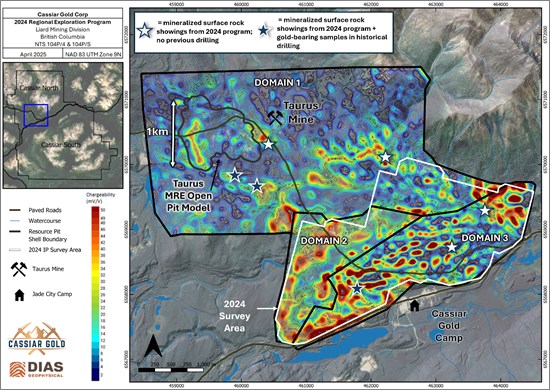Calgary, Alberta--(Newsfile Corp. - May 22, 2025) - Cassiar Gold Corp. (TSXV: GLDC) (OTCQX: CGLCF) ("Cassiar Gold" or the "Company") is pleased to report the results of a series of geophysical surveys conducted across the Cassiar Gold Property in northern British Columbia during the 2024 exploration program (Figure 1). The DCIP, magnetic, and VLF-EM surveys have identified multiple anomalies. These anomalies may be representative of new prospective structures, extensions of known gold-bearing quartz veins, and broad areas of potential hydrothermal alteration and disseminated sulphide mineralization in host rocks similar to those that host the Taurus deposit. These results provide critical structural and geological context to advance the pipeline of targets for the 2025 field-based investigations and future drill targeting.
Highlights:
The 2024 surface program was designed to enhance the geological, geochemical, and geophysical base for exploration beyond established drill targets, providing further context to support potential new discoveries and expansion of known mineralized areas. Several geophysical surveys, reported here, were conducted concurrent to the Company's 2024 diamond drill program. These included 3D DC-resistivity and induced polarization (DCIP), magnetics, and very low frequency electromagnetic (VLF-EM) surveys. The newly acquired data has identified multiple anomalies that will contribute to exploration program planning.
Geophysical surveys completed at Cassiar North (drone-supported magnetics and DCIP) and Cassiar South (drone-supported VLF-EM) identified multiple high-priority targets that have not been tested by previous exploration. Collectively, these datasets:
- Outlined multiple new prospective targets parallel to structures which control mineralization in known productive trends
- Extended the interpreted strike length of several known gold-bearing quartz vein systems
- Identified several previously untested areas with signatures that suggest broad areas of potential prospective alteration of host rocks
"The results from our 2024 field program suggest a structural and geologic setting with potential for mineralized vein systems to span several kilometres," said Jill Maxwell, VP Exploration for Cassiar Gold Corp. "Anomalies identified using new and historical datasets have identified a geophysical signature interpreted to be related to the mineralizing hydrothermal system which extends well beyond the current areas of drilling, opening up new ground for exploration in the upcoming field season."
Figure 1. Cassiar North 2024 field campaign plan view of detailed map areas (yellow stars), grab sample locations, soil sample locations, and DCIP, magnetics, and VLF-EM survey footprints (shown in detail in Figures 2 through 5).
To view an enhanced version of this graphic, please visit:
https://images.newsfilecorp.com/files/2958/252999_cbd4c6088425fae1_002full.jpg
Property Overview
The Cassiar Gold Property hosts several regional prospects with potential to host Taurus deposit-style mineralization in outlying areas to the Taurus bulk-tonnage Inferred gold resource estimate of 1.4 million ounces grading 1.14 grams per tonne (g/t) gold (Au) [1]. High-grade shear veins comprise the deposit style typical of the past-producing mines at the Cassiar South project area which holds potential to host new parallel veins associated with high-grade mineralization, and extensions and fault offsets of past-producing vein systems.
Cassiar North Project Area: DCIP and Drone Magnetics Surveys
The Company contracted Pioneer Exploration Consultants Ltd. ("Pioneer") to complete a drone-based magnetic survey over a 60 km2 area of the northern Cassiar project. Dias Geophysical Ltd. ("Dias") was engaged to complete a 3D direct current-resistivity and induced polarization (DCIP) survey over approximately 6 km2 (Figures 1,2,3,4) of this area with the objective to expand modern data coverage and integrate with 2023 datasets to evaluate the potential for direct detection of quartz vein-associated disseminated sulphide mineralization beyond the extent of the inferred mineral resource. These surveys also aimed to evaluate the potential to identify structural and lithological features that may play a role in controlling, or may host, gold-bearing quartz veins.
Figure 2. Map of the analytical signal response of the 2024 drone-supported magnetics survey conducted at Cassiar North. Apparent magnetic lows (blue dashed lines), peripheral to magnetic highs, bear spatial association with moderate to strong chargeable responses (yellow dashed lines) coincident with areas host to known gold-showings at surface, with & without previous early-stage drilling (blue & white stars, respectively).
To view an enhanced version of this graphic, please visit:
https://images.newsfilecorp.com/files/2958/252999_cbd4c6088425fae1_003full.jpg
Magnetics
The domain that hosts the 2022 Taurus Resource exhibits a strong magnetic response in the survey area with several discrete subcircular magnetic features throughout the domain, one of which coincides with the footprint of the Taurus deposit (Figure 2).
Moderate chargeability anomalies are apparent in the DCIP survey, which may represent direct-detection of gold-related sulphide mineralization occurred near the edges of magnetic anomalies - a pattern noted at both the Taurus deposit and the Wings Canyon brownfields target.
The analytical signal magnetic data revealed several areas of apparent lower magnetism peripheral to magnetic highs, thought to represent areas of magnetite destruction. These zones are interpreted to reflect hydrothermal alteration related to gold-bearing vein systems, similar to the Taurus deposit.
Importantly, newly identified structural lineaments may represent east-northeast extensional splays from a major northwest regional control to mineralization in the district. The interaction of these primary and secondary structures are known to influence the distribution of gold on the property and will be key targets in the coming field season.
DCIP
Dias generated a 3D inversion model of chargeability, conductivity, and resistivity, integrating 2023 and 2024 survey datasets. The integrated datasets outline three distinct geophysical domains, each with promising exploration targets (Figures 2,3).
Domain 1 initially surveyed in 2023 and includes both the Taurus deposit and Wings Canyon target area, hosts moderate chargeability responses associated with known gold and disseminated sulphide mineralization. Anomalies identified east and west of Taurus, and east of Wings Canyon, in areas with lower apparent magnetic responses are considered prospective for follow up.
Domain 2 is characterized by low resistivity and magnetic responses, interpreted to be due to underlying sedimentary rocks, allowing the contact to be traced under cover. A series of discrete chargeability anomalies near the boundary of this domain may represent pyritic alteration envelopes with potential to host gold mineralization and warrant further ground truthing.
Domain 3 exhibits a banded series of resistivity and chargeability lineaments which may indicate a new area of gold-bearing quartz veins with carbonate rich and pyritic alteration envelopes. This series of features is characterized by low magnetic responses and alternating lineaments of high resistivity/low chargeability and moderate resistivity/high chargeability. Much of this area is under cover, as such several IP anomalies have not been explored and present high-quality targets for follow up investigations.
Figure 3. Map of the vertical projection of the DCIP survey chargeability inversion contours (mV/V) of integrated 2023 + 2024 survey data at 50 m constant depth.
To view an enhanced version of this graphic, please visit:
https://images.newsfilecorp.com/files/2958/252999_cbd4c6088425fae1_004full.jpg
Figure 4. Map of the vertical projection of the DCIP survey DC resistivity inversion (Ohm-m) of integrated 2023 + 2024 survey data in plan section at 140m depth below surface relative to the Taurus resource.
To view an enhanced version of this graphic, please visit:
https://images.newsfilecorp.com/files/2958/252999_cbd4c6088425fae1_005full.jpg
Drone VLF
The Company contracted Pioneer Exploration Consultants Ltd. ("Pioneer") to complete a drone-based magnetic survey over a 7.5 km2 area at the Cassiar South project area (Figure 5). The survey was designed to evaluate the suitability of high-resolution modern VLF data to detect known near-surface structures that could host gold-bearing quartz veins, key faults, and geological contacts at the project area, while potentially identifying new exploration targets.
The survey area included the East Bain vein - a known and unmined segment of the past-producing Bain Mine - and the thrust contact between mafic volcanic rocks, known host to gold-bearing veins on the property, and overlying sediments.
The survey successfully outlined the relatively flat lying thrust contact. Results suggest that structures which host the known gold-bearing veins in the area often correspond with breaks or changes in orientation of the thrust fault contact. The presence of such breaks or deflection features will contribute to exploration targeting and prioritization.
Importantly, responses suggest a series of east-northeast trending structural lineaments, including several on-trend with known gold-bearing quartz vein segments. This observed response aligns with the unmined East Bain vein of the past-producing Bain Mine where survey results suggest the vein system may extend well beyond its currently known extent. Several other prospective parallel lineaments were also highlighted and are considered high priority for follow-up investigation.
Figure 5. Plan view map of 2024 drone-supported VLF-EM survey. Interpreted lineaments highlight potential for along strike extensions of known vein systems as well as new blind parallel veins.
To view an enhanced version of this graphic, please visit:
https://images.newsfilecorp.com/files/2958/252999_cbd4c6088425fae1_006full.jpg
Summary
The recent DCIP, magnetic, and VLF-EM surveys at the Cassiar Gold property have successfully identified multiple anomalies which may be representative of new prospective structures, extensions of known gold-bearing quartz veins, or broad areas of potential hydrothermal alteration and disseminated sulphide mineralization in host rocks similar to those that host the Taurus deposit mineralization. These results provide critical structural and geological context to advance the pipeline of targets to guide 2025 exploration, including field-based investigations and drill targeting. The technical team is actively integrating survey outcomes into program planning as we look toward the upcoming field season.
Survey Specifications
The magnetic survey was completed using a GEM Systems GSMP-35U UAV Magnetometer mounted and suspended below a Hercules X4 UAV, with the sensor set to 35 m above ground level. Lines were spaced at 50 m, flown at an azimuth of 022.5o, for a total of 1384 line-kilometres flown.
The principal VLF airborne sensor used was a GEM Systems GSM-90AVU UAV-VLF system being carried in a towed bird with a heavy lift Hercules X8 multirotor UAV, with the sensor set to 45 m above ground level. Lines were set at 50 m spacing and 022.5o orientation, for a total of 155 line-kilometres flown.
The DCIP survey was completed using the DIAS32 acquisition system with a Dias GS5000 25kW transmitter, and a rolling distributed 3D array with pole-dipole transmitter configuration. The inversion model derived from integration of 2023 and 2024 provided near surface resolution of approximately 25 m x 50 m, and a depth search of approximately 400-600 m.
The survey was comprised of 19 transmit lines alternating with 20 receiver lines, oriented southwest-northeast with an azimuth of 016.5o and 175 m spacing. Transmitter stations were spaced 150 m apart and receiver stations were spaced 75 m apart along their respective lines. Two current extensions were extended beyond the ends of the transmit lines to increase depth of investigation along grid margins; a current remote electrode station was established approximately 5 km west of the grid.
Qualified Person
The technical information in this news release has been reviewed and approved by Jill Maxwell, P.Geo., Cassiar Gold Corp.'s VP Exploration, who is a Qualified Person as defined by National Instrument 43-101.
About Cassiar Gold Corp.
Cassiar Gold Corp. is a Canadian gold exploration company holding a 100% interest in its flagship Cassiar Gold Property located in British Columbia, Canada. The Cassiar Gold property spans 590 km2 and consists of two main project areas: Cassiar North, which hosts a NI 43-101-compliant inferred resource estimate of 1.4 Moz at 1.14 g/t Au (cutoff grade of 0.5 g/t Au) known as the Taurus Deposit (see National Instrument 43-101 Technical Report on the Cassiar Gold property, April 28, 2022, by S. Zelligan, J. Moors, C. Jolette, which is available on SEDAR+); and Cassiar South, which hosts numerous gold showings, historical workings, and exploration prospects. Historical underground mines in the Cassiar South area have yielded over 315,000 oz of Au at average head grades of between 10 and 20 g/t Au1, underscoring the high potential for further discovery and expansion of high-grade orogenic gold veins.
The Company also holds a 100% interest in properties covering most of the Sheep Creek gold camp located near Salmo, British Columbia, Canada. The Sheep Creek gold district ranks as the third largest past-producing orogenic gold district in British Columbia with historical gold production of 742,000 ounces gold at an average grade of 14.7 g/t gold from 1900 to 1951. Minimal exploration work has been conducted since the 1950s.
Cassiar Gold Corp. acknowledges, respects, and supports the rights of Traditional First Nations in the lands and communities where we operate.
CONTACT INFORMATION
Jason Shepherd
VP Investor Relations
Cassiar Gold Corp.
E-mail: jasons@cassiargold.com
Phone: 250-212-2122
Forward-Looking Statements
This press release may contain forward-looking statements including those describing Cassiar Gold's future plans and the expectations of management that a stated result or condition will occur. Any statement addressing future events or conditions necessarily involves inherent risk and uncertainty. Actual results can differ materially from those anticipated by management at the time of writing due to many factors, the majority of which are beyond the control of Cassiar Gold and its management. In particular, this news release contains forward-looking statements pertaining, directly or indirectly, to the Company's exploration plans and work commitments.
Although Cassiar Gold believes that the expectations and assumptions on which the forward-looking statements are based are reasonable, undue reliance should not be placed on the forward-looking statements because the Company can give no assurance that they will prove to be correct. Since forward-looking statements address future events and conditions, by their very nature they involve inherent risks and uncertainties, actual results could differ materially from those currently anticipated due to a number of factors and risks. These include, but are not limited to, general economic, market or business conditions, risks associated with the exploration and development industry in general (e.g., operational risks in development, exploration and production; the uncertainty of mineral resource estimates; the uncertainty of estimates and projections relating to production, costs and expenses, and health, safety and environmental risks), constraint in the availability of services, commodity price and exchange rate fluctuations, the COVID-19 pandemic, changes in legislation impacting the mining industry, adverse weather conditions and uncertainties resulting from potential delays or changes in plans with respect to exploration or development projects or capital expenditures.
Readers are cautioned that the foregoing list of risk factors should not be construed as exhaustive. These statements speak only as of the date of this release or as of the date specified in the documents accompanying this release, as the case may be. The Company undertakes no obligation to publicly update or revise any forward-looking statements except as expressly required by applicable securities laws.
Neither the TSX Venture Exchange nor its Regulation Services Provider (as that term is defined in the policies of the TSX Venture Exchange) accepts responsibility for the adequacy or accuracy of this release.
[1] See April 28, 2022, NI43-101 Report titled "National Instrument 43-101 Technical Report on the Cassiar Gold Property" by Zelligan, P.Geo, Moors, P.Geo, Jolette, P.Geo.
To view the source version of this press release, please visit https://www.newsfilecorp.com/release/252999










